Review PDAs HP iPaq hx2410/hx2750
Package:
- PDA
- Cradle
- Charger
- Plastic screen cover
- 2 CD with the software
- Manual
Live photos
HP has a vast model line, all devices can be divided into the following categories: budget (HP iPaq rz1710, the review available here), multimedia (the iPaq rx3000 series, the review available here), business (the hx2000 series, we review it today), Hi-End (HP iPaq hx4700, the review available here), communicators (the h6000/hw6500 series).

The hx2000 series goes under the code name Morpheus. I'd note that this model is produced by LG instead of HTC, as was expected. It was surprising, because the product turned out to be of high quality, which is more typical for HTC than for LG. By the way, the junior model iPaq rz1710 is also made by LG.
The iPaq hx2000 series follows the successive PDA iPaq h2210. The specs have improved with Wi-Fi and a higher capacity battery and nothing else was affected. The iPaq 2210 was taken out of production in December 2004 to be replaced with the new series.

Recently we wrote about the iPaq hx2110, today we deal with two senior models. This review is based on that of the junior model with the focus on the differences. Modification and general features
There are three modifications of the new HP model, see the comparison table below. The green color shows differences that improve the characteristics, the orange color shows those that are worse. If some characteristics are the same for all modifications, the line has no color.
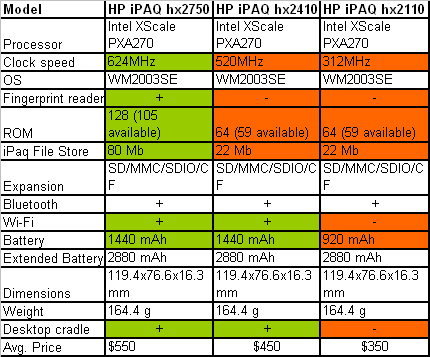
The casing is the same for all modifications, despite the fact that the junior model has neither a high capacity battery nor a fingerprints scanner. The approach for the rx3000 series is applied here. Production cost is less because there was no need to redesign the casing and make a new press-form at the plant.
The senior model has the most features: the most memory size, the highest clock rate, two wireless adapters, a fingerprint scanner and a cradle. It's notable that some specs exceed the top model iPaq hx4700 (RAM size and the fingerprint scanner). The model occupies the top level of the mid price range. It lacks a VGA screen to be a Hi-End model.
The main distinction of the middle model is the lack of the fingerprint scanner. The other features missing aren't that important for Pocket PC - these are the clock rate and RAM size. In those parts of the review where there are no differences between the middle and the senior model, we'll speak about the iPaq hx2750 only.
The junior model is the most simple - it lacks a high capacity battery and Wi-Fi. It makes it similar to HP iPaq 2210.
Design, control elements
The design of the hx2000 series stands out of the general concept by HP, it is not as straight-edged and more rounded so to say. However, the color scheme remained the same - a mix of black and gray. The sides contain rubber insertions. The handheld leaves pleasant emotions when on photos and alive. We should admit the experiments with design proved to be a success. To me, this handheld stands in the same line with the iPaq h1940 considering the appeal, but I'm sure some of you won't agree with it.

The new model has slightly larger dimensions than the iPaq h2210, however you'll notice it only when you place both handhelds nearby. So you can forget about that difference, which is the result of a more capacious battery in the senior modifications and a fingerprint scanner. By the way, if we compare the handheld with Asus A730, the dimensions of both models are the same. Let's compare it with other handhelds:
- HP iPaq rx3710: 114.3x71.2x16.3 mm 158.1 g
- HP iPaq h2210: 115.4x76.4x15.4 mm 144.2 g
- HP iPaq hx2110: 119.4x76.6x16.3 mm 164.4 g
- FS Pocket LOOX 710: 122х72х16.1 mm 180 g
- Dell Axim X50: 119х73х16.9 mm 167 g
The device could have been lighter, however its competitors have comparable weight. The shell feels secure, if you squeeze the device in your hand, you'll hear some creaks (there is no backlash, just sound), but you can forget them easily. The battery compartment cover has a snug fit. The plastic is pleasant to touch. I found it nice that the sides are rubberized, so the device doesn't slide in the hand. If you remember, the iPaq h2210 had a serious drawback along with all its advantages - the rubber side insertions used to fall off with time. The problem had even aggravated, gradually that side insertions had become a rare accessory, and even self-made tuning details emerged (of metal and wood). The construction of side insertions in the new model doesn't make you doubt its safety (they aren't attached to the shell, they are a part of it).

Taking a look at the buttons surrounding the joystick, you'll realize the form was dictated by design and not ergonomics. There are two excessively big and two small buttons. Despite the peculiarity in design of the buttons, it's possible to adjust to them in games. There is an empty space between the screen and buttons, this is where the joystick is on the higher models. There is a relatively loud built-in dynamic mic (it records well within short distances, up to a meter).

Above the screen there are two LED indicators, an HP logo and a power button. At the left side you see a voice recorder button, it's also rubberized and tight and you have to make an effort to press it. At the bottom end you find a reset button and a standard connector for the cradle, the cable and the AC adapter. The top end elements are comfortably located, they do not get mixed up: an SD/MMC slot (SDIO), a Compact Flash slot, a 3.5 mm headphones jack, an infrared port and a silo. The sound in the headphones is of perfect quality and you can use the PDA as an MP3 player. The stylus is like any other from the new HP line.

The back panel has the battery compartment, a couple of standard stickers and nothing more.
Fingerprints scanner
It's not the first time when a fingerprints scanner is used in PDA, there was the 5000 series by HP with this feature.

This is an additional tool to protect data from unauthorized access. In the menu you can adjust protection mode - authentication by fingerprint only or by fingerprint and password. In the menu you can set the number of tries. It's impossible to set scanner sensitivity.
Before you start, you should train the system to recognize left and right forefingers, it's not difficult, and then you can add the rest fingers to the memory. After you complete the procedure, the handheld will demand that you press your finger to the scanner at each startup, only then you'll be able to use the applications and data on PDA.
I'd say that during the exploitation the security system proved to be good - the authentication runs quickly, almost without mistakes. By all that you can be sure that an unauthorized person won't get into the info (should the latter not resort to various technical tricks with fake fingerprints).
Kit
The kit for HP iPaq hx241/hx2750 contains a cradle, its design is the same as in the whole new PDA line by HP.

I'll focus on the screen cover. It is fixed on the sides and is easy to remove. The cover is translucent and you can see the screen well. You can open it to work with the handheld in the usual way and the cover doesn't interfere, even if the headphones are plugged. The minus here is that the cover hides all control elements except for the voice recorder button. In all, the screen cover proves to be a good thing, it's high time to realize something of the kind (there is no need to carry the device in a case, as the main vulnerable art of the PDA, the screen, is protected). However, we handled the device for a long time and noticed an unpleasant thing about it - even if you treat it carefully the plastic of the screen gets small scratches.
Screen
The handheld is equipped with a typical screen for mid range and low end Pocket PCs featuring a transflective TFT matrix with a 3.5" diagonal and a 320x240 pixel resolution. It renders colors perfectly indoors and outdoors and it is good under the direct sunlight. It's the best screen among the analogs (320x240 pixels), comparable with the h2210. There are 21 backlight levels and the lowest level has the quality comparable with the h2210. That means, it's comfortable to work with in the dark, the backlight doesn't hurt eyes, as it happens with some PDA's whose minimum backlight level is high.
Being one of the best among 3.5" 320x240 screens, it can't be compared with VGA screens of top handhelds.

Battery
The PDA has a removable Li-Ion battery that is 1440 mAh in the higher models and the offline performance isn't outstanding. Our tests revealed that under the maximum load (the highest backlight level, video playback, wireless adapters on) the PDA lasted 3 hours 12 minutes. In the MP3 player mode (the screen off, the playback from the storage card) the handheld was good for some 15 hours, the same results are in the reading mode. With the battery life the iPaq hx2410/2750 yields to the iPaq rx3750 equipped with the battery of the same capacity, it happens because the processor by Samsung consumes less power. The handheld by Fujitsu Siemens outpaces the iPaq hx2750, as it has a higher capacity battery onboard.

There is a higher capacity battery of 2880 mAh available (it's compatible with the iPaq rx3000 series and sold together with an extra charger).
Interface
The iPaq hx2750 comes with two integrated wireless interfaces. This is a custom couplee of Wi-Fi and Bluetooth for mid range and high end models.


Bluetooth. Traditionally for HP this model comes with time-proved Broadcom drivers. All necessary profiles are available, including the voice profile. We had no problems with Bluetooth functionality, all profiles worked smoothly: Internet access via the phone, data synchronization with PC, exchanges of files and contacts and so on. The driver's version is 1.5.0 Build 2900. There is the support of several simultaneous connections.
 
Wi-Fi. This wireless adapter worked with no problems and showed good sensitivity. The built-in Wi-Fi manager has poor settings, however it can adjust power consumption and set the switch conditions to another wireless network (a weak signal or no signal at all).
 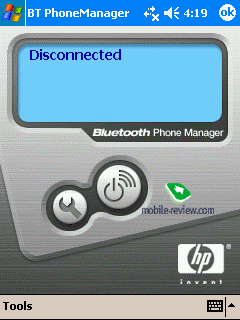
I'd mark a useful utility - BT PhoneManager. It helps in setting Internet connection via the phone (you only need to know access point, login and password).
Productivity, RAM
The handheld has 128 MB of RAM onboard. The available RAM claimed is 123.53 MB. The iPAQ File Store has maximum size of 82.92 MB.
The device is equipped with an Intel PXA270 624 MHz processor. As I noticed while handling the PDA, everything worked with lightning speed, the start menu pops up in an instant. Such speed is excessive and in most cases it is useless. To test the productivity performance with the SPB Benchmark package we've chosen handhelds supporting Bluetooth (several relatively old models included).

This index describes Pocket PC's CPU speed. The first test on the iPaq hx2750 takes the lead on productivity performance and doesn't lose it till the end.

The file system index describes the Pocket PC file system speed (read/record/move). This time again the iPaq hx2750 is far ahead.

The platform index describes the total Pocket PC platform speed including the built-in applications. The picture hasn't changed.
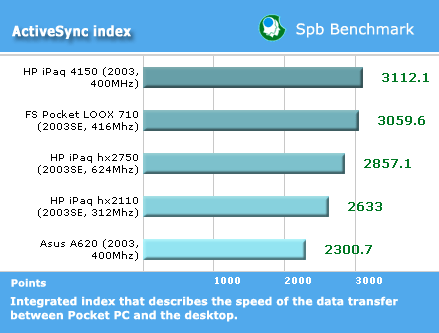
Synchronization speed of the new HP handheld is high slightly yielding to the leader.
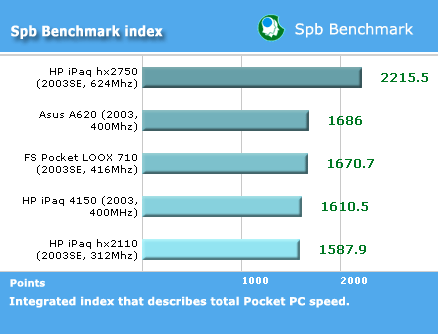
Integrated SPB Benchmark index describes the total Pocket PC speed. The handheld has the best results from the Pocket PC's with QVGA screens. The fact can be explained by the clock rate. Most manufacturers do not install 624 MHz processors to PDAs with QVGA screens (the mid modification can be easily sped up), as it features excessive performance.
Let's see the test results in real applications, they are closer to the truth. During video playback the PDA turned out the best. In this very case with idle Wireless MMX optimization we played 4 clips at different stream intensity, the index was formed on the basis of dropped frames. A higher index implies less dropped frames. The index 1000 means that there are no dropped frames at all.

To test graphics productivity we ran tests of the PocketQuake game in the mute mode (turn the sound off by nosound 1, console command, leaving other settings unchanged). It's an averaged figure by two tests (Demo 1 and Demo 2). The results confirmed our expectations:

In result: this is the most productive PDA with a QVGA screen. In most applications, including video playback, you won't notice the difference between sped up FS LOOX 710 and the iPaq hx2110. The only task where the advantage of the iPaq hx2750 is obvious concerns different games and console emulators (for example, Game Boy Advance emulation, even Asus A620 hardly coped with it).
In case you need a higher clock rate for a particular task, it's possible to speed up the processor (the only possible problem here is the hard reset with the loss of all data). For example, we've sped up the processor by the XCPUScalar utility and measured productivity growth with Beta Player and Wireless MMX optimization on. The PDA performed stable work up to a 663 MHz clock rate. Higher rates provoked hangs and unsteady work.
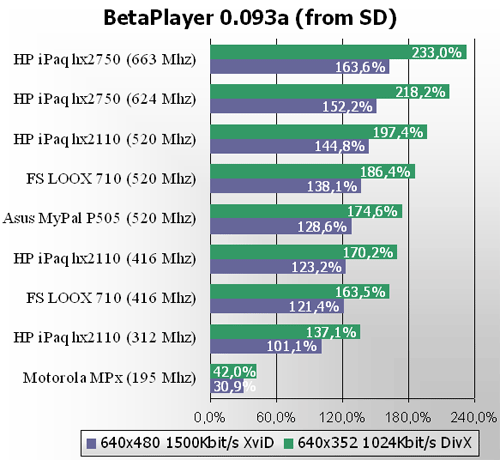
Software
The handheld is powered by Windows Mobile 2003 for Pocket PC Second Edition.
Now let's pass over to non-standard built-in applications.
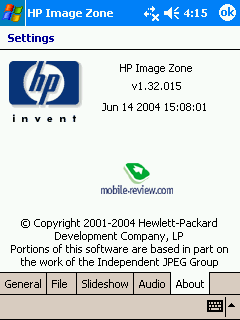 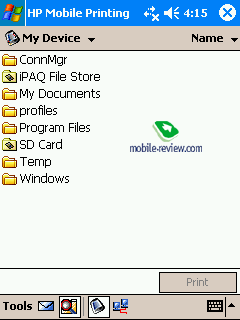
HP Mobile Printing. The utility prints files from the PDA by means of Bluetooth or infrared port.
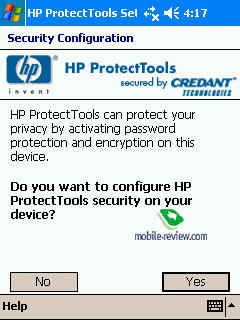 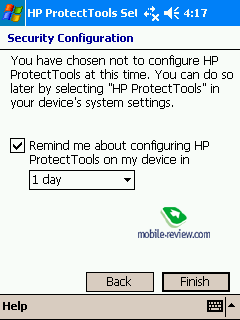
HP Protect Tool. It protects info - data encoding and protection from an unauthorized access.
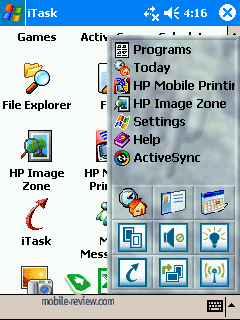 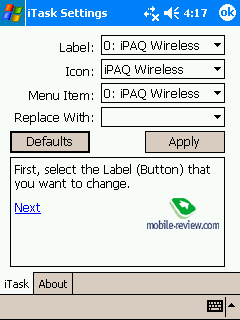
iTask. It's a task manager to switch among the programs and close them. Note, with its help you can rotate or switch the screen off.
 
HP Image Zone. The traditional application by HP to view photos.
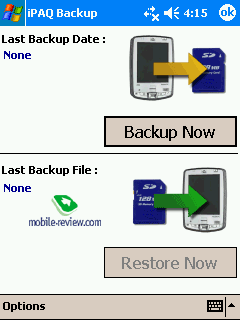 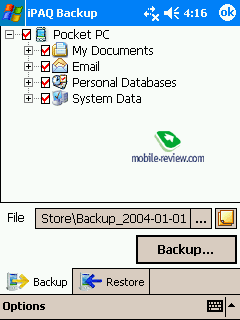
iPaq Backup. This is a functional utility for data backup, one of the best in its class. It can run backups on the schedule, store the data of the organizer in the iPaq file Store.
ImpressionThe iPaq hx2410/hx2750 competes with FS Pocket LOOX 710 and the higher model, Dell X50. The model by Fujitsu Siemens wins with longer battery life and ergonomics, however it has a larger size. The iPaq hx2750 stands out with its unique function (the fingerprint scanner), in the view of marketing it look more attractive due to a higher clock rate and larger memory. The iPaq hx2410 is at the same level with FS Pocket LOOX 710 and only you can say for sure which model is better, the choice will made in respect of the price, design and brand preference. The Dell handheld has a better price, but it lags behind from the others with its battery life.
You shouldn't buy the iPaq hx2410 instead of the iPaq hx2110 because of higher performance, according to our review the junior model gets sped up easily. However, battery life is a matter in the assessment. We think the iPaq hx2750 is your true choice, if you really need the fingerprint scanner.
Despite of the fact that the Korean company LG produced the models, they proved to be well done and the assembly quality is high. We liked the design, which is unusual for a PDA and the handheld has its style. The handheld combines relatively small dimensions, two slots for expansion, Bluetooth and Wi-Fi modules, a good screen and perfect performance. The only bad thing is the high price. To me, the adequate price for the senior model should be around $470-480, and for the mid model - $400.
While I tested the devices, I was thinking that the PDA would be outstanding with a VGA screen instead of a quarter of it. But the 640x480 resolution screens are available only in expensive, high-end Pocket PC's. Description
- Class: business
- Position in the line: above the iPaq hx 2110
- Operating system: Windows Mobile 2003 Second Edition
- Processor: Intel XScale PXA270 624 MHz
- RAM:128 MB (123.53 MB available)
- ROM: 82.92 MB available
- Connectivity: SD/MMC slot (SDIO), Compact Flash Type II, IrDA, Bluetooth 1.2, Wi-Fi, USB 1.1 client
- Screen: 3.5" (active zone: 53x71 mm) 240x320 pixels, 65K colors
- Battery: removable Li-Ion 1440 mAh
- Dimensions: 119.4x76.6x16.3 mm
- Weight: 164.4 g.
Anton Kotov (anton.kotov@mobile-review.com)
Translated by Anja Rytchkova (anja.rytchkova@mobile-review.com)
Published - 14 April 2005
Have something to add?! Write us... eldar@mobile-review.com
|


































